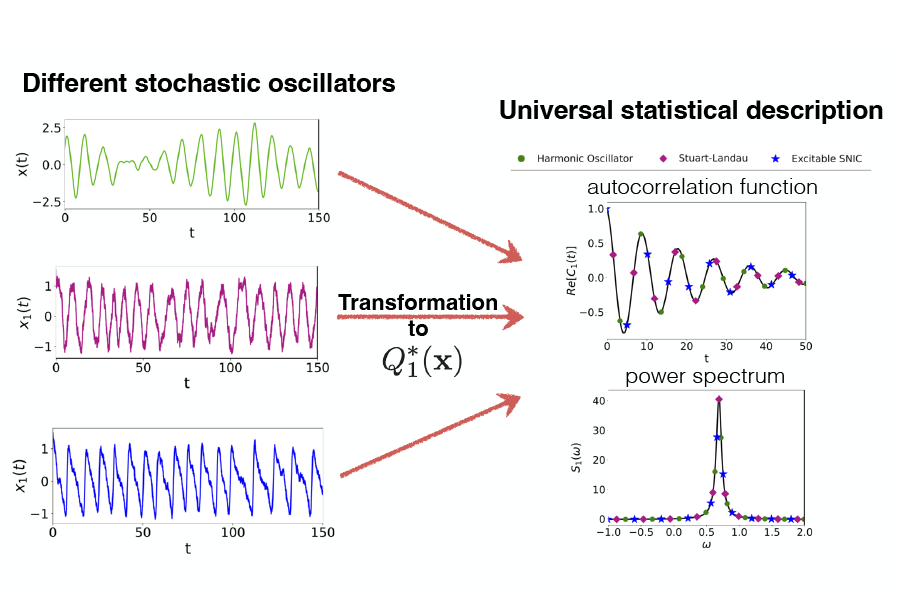PNAS publication: A universal description of stochastic oscillators
What do the beating of the human heart, the flashing of fireflies in a field, and the swinging of children on a playground have in common? They are all examples of rhythmic processes oscillations that occur spontaneously. Oscillations can be found everywhere, and arise from many different underlying physical, chemical, or biological mechanisms.

Bernstein members involved: Benjamin Lindner
Most oscillations are “noisy” or irregular, to a greater or lesser extent. For example, the heart rhythm is not 100% regular. A natural variation of 5-10% in the heart beat is considered healthy.
If you’ve ever been in an audience that spontaneously started clapping, you know the claps are not perfectly synchronized – there’s always someone a little early or a little late. Yet the rhythm will still coalesce, grow in intensity, and eventually break up.
Because they arise from a myriad of different underlying mechanisms – called “bifurcations” by theoretical physicists – the theoretical descriptions of these phenomena have been scattered. Physicists have understood different kinds of oscillations on a case-by-case basis.
In a paper that has just been published at the Proceedings of the National Academy of Sciences, an interdisciplinary team with expertise spanning physics, neuroscience, and mathematics have introduced a new “universal description” of stochastic oscillators. The new work uses complex numbers to describe both the timing of oscillators, and how noisy, or imprecise in their timing, they are. The scientists’ invention makes it possible to compare oscillators that were previously considered to have completely different properties.
One of the study’s authors, applied mathematician Peter Thomas from Case Western Reserve University in Cleveland, Ohio, explains: “In San Francisco, modern skyscrapers sway in the wind. As they are buffeted by randomly shifting air currents, buildings are pushed slightly out of their vertical posture, but the mechanical properties of the structure pull them back – like a mass on the end of a spring. This combination of flexibility and resilience helps high rise buildings survive shaking during earthquakes. You wouldn’t think this process could be compared with, say, the pendulum on a grandfather clock or a child on a swing, but they are all oscillators. And our new formalism lets you compare them, apples-to-apples.”
At the heart of the study is a mathematical transformation to a new variable, that strikingly simplifies the description. As physicist Benjamin Lindner from Humboldt University in Berlin, Germany, last author of the study, puts it, “Noisy oscillators are characterized by their temporal correlation, by their response to an external forcing, and by the way they interact if coupled to other oscillators. If we look at the system through the transformed variable, these characteristics follow very simple and exact formulas – there is no approximation involved.”
“What makes this work so exciting is that oscillations are everywhere, once you know what to look for,” says computational neuroscientist Boris Gutkin from Ecole Normale Superieure in Paris. “From satellites going around the earth to the synchronization of fireflies in a tree, or brain rhythms that kick up when we comprehend language, we have found a truly universal description of stochastic oscillators.”
The study’s lead author, Alberto Perez-Cervera, an applied mathematician from Universidad Complutense de Madrid, says “The mathematical transformation we put forward in the paper acts as a lens through which we invite the reader to observe noisy oscillators. We expect the reader to enjoy the striking experience of observing how different and, a priori, complex phenomena become comparable and categorized under simple, but still meaningful, universal mathematical forms when observed through our lens.”




